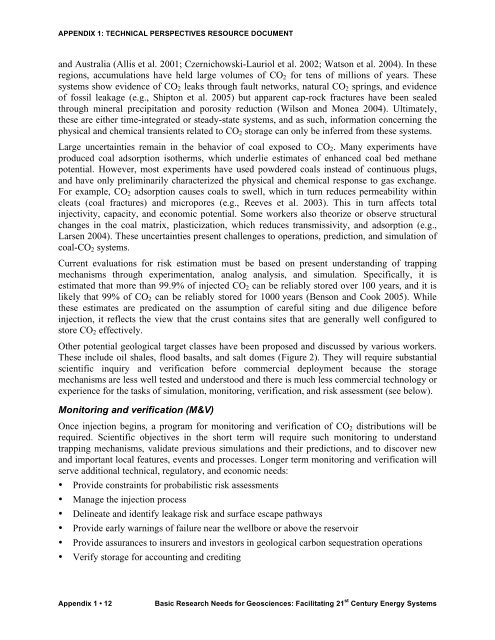Basic Research Needs for Geosciences - Energetics Meetings and ...
Basic Research Needs for Geosciences - Energetics Meetings and ...
Basic Research Needs for Geosciences - Energetics Meetings and ...
- No tags were found...
You also want an ePaper? Increase the reach of your titles
YUMPU automatically turns print PDFs into web optimized ePapers that Google loves.
APPENDIX 1: TECHNICAL PERSPECTIVES RESOURCE DOCUMENT<strong>and</strong> Australia (Allis et al. 2001; Czernichowski-Lauriol et al. 2002; Watson et al. 2004). In theseregions, accumulations have held large volumes of CO 2 <strong>for</strong> tens of millions of years. Thesesystems show evidence of CO 2 leaks through fault networks, natural CO 2 springs, <strong>and</strong> evidenceof fossil leakage (e.g., Shipton et al. 2005) but apparent cap-rock fractures have been sealedthrough mineral precipitation <strong>and</strong> porosity reduction (Wilson <strong>and</strong> Monea 2004). Ultimately,these are either time-integrated or steady-state systems, <strong>and</strong> as such, in<strong>for</strong>mation concerning thephysical <strong>and</strong> chemical transients related to CO 2 storage can only be inferred from these systems.Large uncertainties remain in the behavior of coal exposed to CO 2 . Many experiments haveproduced coal adsorption isotherms, which underlie estimates of enhanced coal bed methanepotential. However, most experiments have used powdered coals instead of continuous plugs,<strong>and</strong> have only preliminarily characterized the physical <strong>and</strong> chemical response to gas exchange.For example, CO 2 adsorption causes coals to swell, which in turn reduces permeability withincleats (coal fractures) <strong>and</strong> micropores (e.g., Reeves et al. 2003). This in turn affects totalinjectivity, capacity, <strong>and</strong> economic potential. Some workers also theorize or observe structuralchanges in the coal matrix, plasticization, which reduces transmissivity, <strong>and</strong> adsorption (e.g.,Larsen 2004). These uncertainties present challenges to operations, prediction, <strong>and</strong> simulation ofcoal-CO 2 systems.Current evaluations <strong>for</strong> risk estimation must be based on present underst<strong>and</strong>ing of trappingmechanisms through experimentation, analog analysis, <strong>and</strong> simulation. Specifically, it isestimated that more than 99.9% of injected CO 2 can be reliably stored over 100 years, <strong>and</strong> it islikely that 99% of CO 2 can be reliably stored <strong>for</strong> 1000 years (Benson <strong>and</strong> Cook 2005). Whilethese estimates are predicated on the assumption of careful siting <strong>and</strong> due diligence be<strong>for</strong>einjection, it reflects the view that the crust contains sites that are generally well configured tostore CO 2 effectively.Other potential geological target classes have been proposed <strong>and</strong> discussed by various workers.These include oil shales, flood basalts, <strong>and</strong> salt domes (Figure 2). They will require substantialscientific inquiry <strong>and</strong> verification be<strong>for</strong>e commercial deployment because the storagemechanisms are less well tested <strong>and</strong> understood <strong>and</strong> there is much less commercial technology orexperience <strong>for</strong> the tasks of simulation, monitoring, verification, <strong>and</strong> risk assessment (see below).Monitoring <strong>and</strong> verification (M&V)Once injection begins, a program <strong>for</strong> monitoring <strong>and</strong> verification of CO 2 distributions will berequired. Scientific objectives in the short term will require such monitoring to underst<strong>and</strong>trapping mechanisms, validate previous simulations <strong>and</strong> their predictions, <strong>and</strong> to discover new<strong>and</strong> important local features, events <strong>and</strong> processes. Longer term monitoring <strong>and</strong> verification willserve additional technical, regulatory, <strong>and</strong> economic needs:• Provide constraints <strong>for</strong> probabilistic risk assessments• Manage the injection process• Delineate <strong>and</strong> identify leakage risk <strong>and</strong> surface escape pathways• Provide early warnings of failure near the wellbore or above the reservoir• Provide assurances to insurers <strong>and</strong> investors in geological carbon sequestration operations• Verify storage <strong>for</strong> accounting <strong>and</strong> creditingAppendix 1 • 12<strong>Basic</strong> <strong>Research</strong> <strong>Needs</strong> <strong>for</strong> <strong>Geosciences</strong>: Facilitating 21 st Century Energy Systems
















